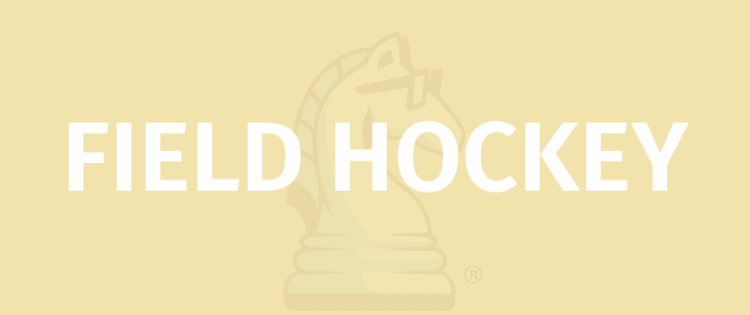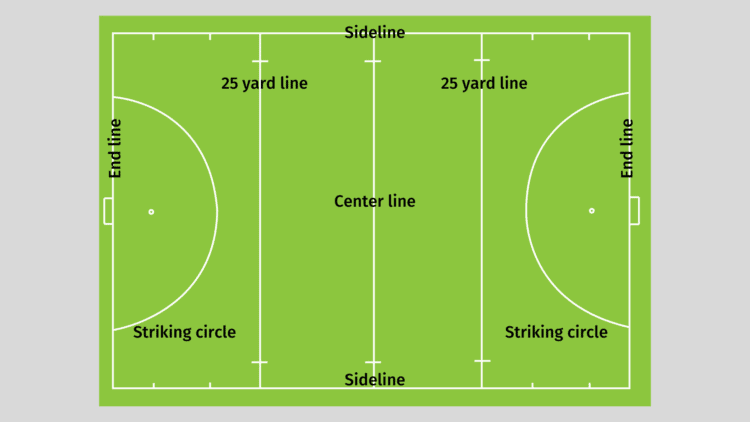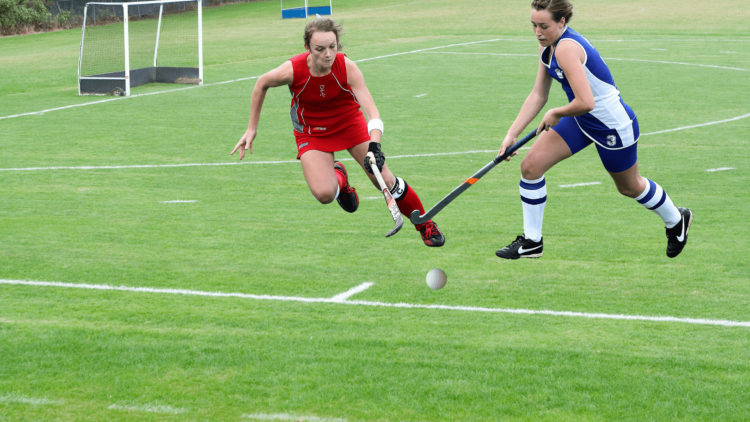
OBJECTIVE OF FIELD HOCKEY: Score more points than the opposing team by hitting the field hockey ball into the other team’s goal with a hockey stick.
NUMBER OF PLAYERS: 22, 11 players on each team
MATERIALS: 1 hockey stick per player, field hockey ball, 2 field hockey goal, pads for the goalkeepers
TYPE OF GAME: Sport
AUDIENCE: 8+
OVERVIEW OF FIELD HOCKEY
Field hockey is similar to ice hockey, with some key differences. The sport is popular in Western Europe and North America and is usually played on outdoor grass courts or turf. Field hockey has the fastest average swing speed of any sport at around 103 MPH!
SETUP

FIELD
The standard field size for field hockey is 300 feet (100 meters) long and 167 feet wide. A field hockey field’s boundaries are marked with the end lines going across the width and sidelines going across the length.
The field is divided into quarters by four lines. The 25-yard lines are 25 yards from each end line, and the center line runs through the middle of the field. The goalposts are 12 feet wide, 7 feet tall, and 4 feet deep. Each goal post is situated in the center of each end line.
The striking circle is a semi-circle with a radius of around 48 feet surrounding each goal.
PLAYERS
There are always 22 players on the field, 11 from each team. Each team has a goalkeeper and 10 fielders.
GOALKEEPER
The goalkeeper generally stays near the goalpost and is allowed to use any part of their body as well as their hockey stick to block the ball. Goalkeepers must wear extra padding to avoid injury.
FIELDERS
All other players on a field hockey team are only allowed to contact the ball with their hockey stick. Fielders generally start in a formation with 5 offensive players near the center line and 5 defensive players near the goal, but as the game progresses, players do not necessarily stay in this formation.
GAMEPLAY

Field hockey is divided into four 15-minute quarters. There is also a short break between each quarter for the teams to switch sides. A field hockey game starts with a coin toss, the winner of which can choose whether to start with the ball or not. The team that loses the coin toss will start with the ball during the 2nd quarter.
PASSING/MOVING THE BALL
The main objective of field hockey is the move the ball down the field and score a point by making the ball go into the opposing team’s net. Hockey sticks have a “front face” and a “back face.” Players can only use this front face to hit the ball. Players also cannot hit the ball with any part of their body.
Players can either dribble the ball downfield or pass the ball to a teammate.
SCORING
For a goal to count in field hockey, a fielder must shoot from within the striking circle. The only way a shot can count if it is made from outside the striking circle is if an opponent or teammate deflects or redirects it into the goal.
PENALTIES
If a team makes an error, breaks the rules, or fouls the other team, the umpire will call a penalty, and one of the following will occur.
FREE HIT
When an error occurs outside the striking circle, a free hit is awarded. The free hit will be given exactly where it occurred on the field.
PENALTY CORNER
A penalty corner occurs when a player commits a foul within the striking circle. A common foul that results in a penalty corner is the ball touching a player’s foot inside the striking circle. During a penalty corner, the ball is placed on the end line 33 feet away from the goal post. A player from the team that did not commit the foul hits the ball, attempting to score from the corner.
FREE STROKE
A free stroke is taken when a defender fouls in the striking circle, and the foul prevents a goal. The free stroke is awarded to the offensive player who was fouled. Then, the offensive player takes a free stroke facing the goalkeeper, 21 feet from the goal. No defensive fielder is allowed to interfere during the free stroke.
PENALTIES FOR PLAYERS
Green card: Green cards are used to warn the players for minor fouls such as handling the ball, obstructing a strike, or hitting the ball with the rounded side of the stick. If the same offense is repeated, the umpire will give the player a yellow card.
Yellow card: Yellow cards are given to players who commit multiple minor rule violations, resulting in the player being suspended for 5 minutes.
Red card: This is when the referee deems that a player, manager, or coach has committed a serious violation of the game’s rules and will be sent off the field for the rest of the game without bringing in a substitute. A player who gets a red card will also not be allowed to attend the next scheduled match. Red card violations include fighting, shoving, intentionally tripping, or checking opponents with their sticks. Red cards are also given to players who get 2 yellow cards for minor rule violations.
END OF GAME
At the end of the 4th quarter, the team with the most points wins.
If no team wins at the end of the game, an overtime period of 10 minutes will be added to the game. At the end of this period, the team with the highest score wins.
If, after extra time, there is still no winning team, a shootout takes place. 5 players from each team will individually confront the goalkeeper and attempt to score. The team that scores the most points in the shootout will then win the match.
- 30 GAMES TO PLAY OVER TEXT - April 22, 2024
- 20+ FREE PRINTABLE BABY SHOWER GAMES - April 16, 2024
- 20+ College Party Games for the Best Night Ever! - April 2, 2024